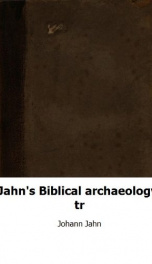jahns biblical archaeology

Purchase of this book includes free trial access to www.million-books.com where you can read more than a million books for free. This is an OCR edition with typos. Excerpt from book: BIBLICAL ARCHAEOLOGY. PART FIRST. ON DOMESTIC ANTIQUITIES. CHAPTER I . § 4. Biblical As it seems necessary that something should be known respecting the theatre of the memorable events in the Bible, before proceeding further we shall give a concise view of biblical or sacred geography. Lest we should delay too long in the threshold, we shall not now discuss the situation of the countries, mentioned Gen. 10: o 10, etc., shall say nothing respecting the origin of the Tigris and Euphrates, and shall omit the geography of Asia Minor nnd Greece. We proceed, therefore, to state in a lew words the situation of those countries, which occur more frequently in the Bible. § 5. Aram E A. The region, which in the Bible is denominated Aram, cx, is a vast tract, extending from Mount Taurus south as far as Damascus and Babylonia, and from the Mediterranean Sea in aiI chapter{Section 46 § 0. ARAMEA. eastern direction beyond the Tigris into Assyria. Different parts of it are called by different names. I. Aram beth Rechob, airn rva cs, otherwise called Assyria; in the most limited meaning of the term, it was a small province or peninsula surrounded by the Tigris, and the less and greater Zab. Its extent was increased in the progress of time by the addition of seven other provinces, and in the age of Isaiah and Ahaz, it became, by the accession of other territories still, which extended into Syria and Palestine, the very large empire of Assyria. Its metropolis, Nineveh, was situated on the eastern shore of the Tigris, nearly opposite the site of Mosul at the present day. It was laid waste in the year 877 before Christ by Arbaces and Belesis, but was rebuilt; it was laid waste again by Cyaxares I. and Nabopolassar in the year 625 before Christ, and ever afterwards remaine...
Info about the book
Author:
Series:
Unknown
ASIN:
B008LOWZL4
Rating:
4.5/5 (5)Your rating:
0/5
Languge:
English
Users who have this book
Users who want this book
What readers are saying
What do you think? Write your own comment on this book!
write a commentGenre
if you like jahns biblical archaeology try:
Do you want to exchange books? It’s EASY!
Get registered and find other users who want to give their favourite books to good hands!


